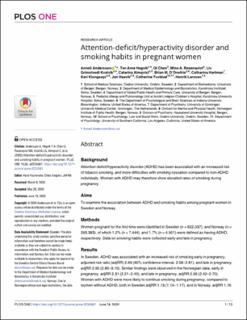Attention-deficit/hyperactivity disorder and smoking habits in pregnant women
| dc.contributor.author | Anderson, Anneli | |
| dc.contributor.author | Hegvik, Tor-Arne | |
| dc.contributor.author | Chen, Qi | |
| dc.contributor.author | Kvalvik, Liv Grimstvedt | |
| dc.contributor.author | Almqvist, Catarina | |
| dc.contributor.author | D'Onofrio, Brian M. | |
| dc.contributor.author | Hartman, Catharina A | |
| dc.contributor.author | Klungsøyr, Kari | |
| dc.contributor.author | Haavik, Jan | |
| dc.contributor.author | Tuvblad, Catherine | |
| dc.contributor.author | Larsson, Henrik | |
| dc.date.accessioned | 2021-06-14T11:18:04Z | |
| dc.date.available | 2021-06-14T11:18:04Z | |
| dc.date.created | 2021-02-12T12:22:26Z | |
| dc.date.issued | 2020 | |
| dc.identifier.issn | 1932-6203 | |
| dc.identifier.uri | https://hdl.handle.net/11250/2759268 | |
| dc.description.abstract | Background Attention-deficit/hyperactivity disorder (ADHD) has been associated with an increased risk of tobacco smoking, and more difficulties with smoking cessation compared to non-ADHD individuals. Women with ADHD may therefore show elevated rates of smoking during pregnancy. Aims To examine the association between ADHD and smoking habits among pregnant women in Sweden and Norway. Methods Women pregnant for the first time were identified in Sweden (n = 622,037), and Norway (n = 293,383), of which 1.2% (n = 7,444), and 1.7% (n = 4,951) were defined as having ADHD, respectively. Data on smoking habits were collected early and late in pregnancy. Results In Sweden, ADHD was associated with an increased risk of smoking early in pregnancy, adjusted risk ratio (adjRR) 2.69 (95% confidence interval, 2.58–2.81), and late in pregnancy, adjRR 2.95 (2.80–3.10). Similar findings were observed in the Norwegian data, early in pregnancy, adjRR 2.31 (2.21–2.40), and late in pregnancy, adjRR 2.56 (2.42–2.70). Women with ADHD were more likely to continue smoking during pregnancy, compared to women without ADHD, both in Sweden adjRR 1.13 (1.10–1.17), and in Norway, adjRR 1.16 (1.12–1.20). Having a sibling diagnosed with ADHD was associated with an increased risk of smoking early and late in pregnancy, in both Sweden and Norway. Conclusions Women with ADHD are considerably more likely to smoke early and late in (their first) pregnancy and are less likely to stop smoking between the two time points. Smoking, early and late in pregnancy, co-aggregates in families with ADHD. Smoking prevention and intervention programs should be targeted towards women with ADHD, specifically during their childbearing years, to ensure better mother and child outcomes. | en_US |
| dc.language.iso | eng | en_US |
| dc.publisher | Public Library of Science | en_US |
| dc.rights | Navngivelse 4.0 Internasjonal | * |
| dc.rights.uri | http://creativecommons.org/licenses/by/4.0/deed.no | * |
| dc.title | Attention-deficit/hyperactivity disorder and smoking habits in pregnant women | en_US |
| dc.type | Journal article | en_US |
| dc.type | Peer reviewed | en_US |
| dc.description.version | publishedVersion | en_US |
| dc.rights.holder | Copyright 2020 Andersson et al. | en_US |
| dc.source.articlenumber | e0234561 | en_US |
| cristin.ispublished | true | |
| cristin.fulltext | original | |
| cristin.qualitycode | 1 | |
| dc.identifier.doi | 10.1371/journal.pone.0234561 | |
| dc.identifier.cristin | 1889159 | |
| dc.source.journal | PLOS ONE | en_US |
| dc.relation.project | Stiftelsen Kristian Gerhard Jebsen: SKGJ-MED-02 | en_US |
| dc.relation.project | EC/H2020/728018 | en_US |
| dc.relation.project | EC/H2020/667302 | en_US |
| dc.identifier.citation | PLOS ONE. 2020, 15 (6), e0234561. | en_US |
| dc.source.volume | 15 | en_US |
| dc.source.issue | 6 | en_US |
Tilhørende fil(er)
Denne innførselen finnes i følgende samling(er)
-
Department of Biomedicine [708]
-
Registrations from Cristin [9489]

